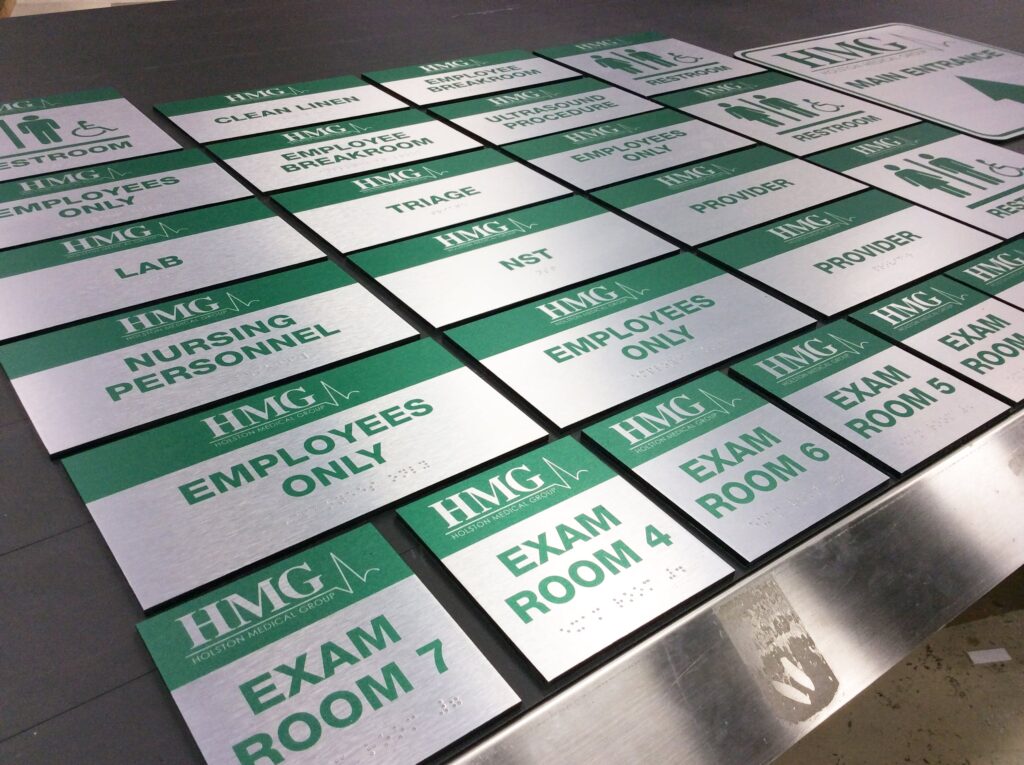How to Ensure Your Business is ADA Compliant

Ensuring that your business is compliant with the Americans with Disabilities Act (ADA) is not just a legal requirement but a moral obligation. In today’s inclusive society, accessibility for all individuals, including those with disabilities, is paramount. This article, provided by Heritage Signs & Displays, will guide you through the essential steps to guarantee your business meets ADA standards. From understanding the significance of compliance to implementing the necessary signage and digital accessibility, we will explore how to create a welcoming and inclusive environment for all customers.
Understanding the Importance of ADA Compliance for Businesses
In the world of business, being ADA compliant isn’t just a suggestion; it’s a necessity. The Americans with Disabilities Act (ADA) sets forth legal requirements that ensure equal access and opportunities for people with disabilities. Not only is ADA compliance a legal obligation, but it also reflects a commitment to inclusivity and diversity within your business operations.
The Legal and Ethical Imperatives of ADA Compliance
Failing to meet ADA requirements can result in costly lawsuits, hefty fines, and damage to your brand’s reputation. Ethically, ensuring that your business is accessible to everyone, regardless of their abilities, is simply the right thing to do. By prioritizing ADA compliance, you demonstrate your commitment to treating all customers and employees with respect and dignity.
Benefits of Being ADA Compliant for Businesses
While avoiding legal trouble is a compelling reason to be ADA compliant, there are also business benefits to consider. By making your business accessible to a wider range of customers, you increase your potential market reach and revenue streams. Additionally, providing a welcoming and inclusive environment can enhance customer loyalty and positive brand perception.
Key Requirements of the Americans with Disabilities Act (ADA)
To ensure your business meets ADA standards, it’s essential to understand the key requirements set forth by the ADA.
Overview of ADA Regulations and Standards
The ADA covers a wide range of areas, from building accessibility to communication needs. Familiarize yourself with the ADA standards for accessible design, as outlined in the ADA Accessibility Guidelines (ADAAG) and the ADA Standards for Accessible Design. These regulations provide clear guidelines on how to make your business environment more inclusive for individuals with disabilities.
Specific ADA Requirements for Signs and Displays
When it comes to signage and displays, the ADA has specific requirements to ensure they are accessible to all individuals. From proper placement and sizing to using easy-to-read fonts and tactile elements, adhering to ADA guidelines for signage is crucial for creating a welcoming and inclusive space.
Implementing ADA Compliant Signage and Displays
Creating ADA compliant signage and displays involves thoughtful planning and attention to detail.
Design Considerations for ADA Compliant Signage
When designing ADA compliant signage, consider factors such as contrast, readability, and tactile features for individuals with visual impairments. Ensure that your signs are easily understandable and accessible to all individuals, including those with disabilities.
Choosing the Right Materials and Fonts
Selecting the appropriate materials and fonts for your signage is key to ADA compliance. Opt for high-contrast colors and non-glare finishes for better visibility. Choose fonts that are easy to read and understand, especially for individuals with dyslexia or other reading challenges.
Navigating Accessibility Guidelines for Physical Spaces
Ensuring your business’s physical spaces are accessible goes hand in hand with ADA compliant signage.
Creating Accessible Paths of Travel and Entrances
Make sure that pathways, entrances, and exits are wide enough to accommodate individuals using mobility devices such as wheelchairs or walkers. Installing ramps, handrails, and automatic doors can improve accessibility and ease of movement around your business premises.
Ensuring Proper Signage Placement and Visibility
Strategically place signage at eye level and in locations that are easily visible from different vantage points. Consider lighting conditions and glare to ensure that your signs are legible in various settings. Clear and visible signage not only enhances accessibility but also contributes to a positive customer experience.
Ensuring Digital Accessibility for Online Platforms
Understanding Web Content Accessibility Guidelines (WCAG)
To make your online platforms accessible to everyone, it’s crucial to familiarize yourself with the Web Content Accessibility Guidelines (WCAG). Think of these guidelines as the friendly neighborhood superhero team coming to rescue your website from digital exclusion. WCAG lays down the law on how to ensure that people with disabilities can navigate your site with ease. Following these guidelines not only broadens your audience but also shows that your business is all about inclusivity and accessibility for all.
Optimizing Websites and Online Content for Accessibility
Picture this: your website is a sparkling digital mansion, and you want everyone to feel welcome in it. By optimizing your online content for accessibility, you’re rolling out the red carpet for all visitors, regardless of any disabilities they might have. Simple tweaks like adding alt text to images, using clear headings, and providing transcripts for videos can make a world of difference. It’s like giving your website a makeover that not only looks great but also feels great for everyone who stops by.
Training Staff on ADA Compliance and Customer Service
Importance of Staff Training in ADA Compliance
Imagine your staff as the frontline warriors, wielding the sword of ADA compliance and championing inclusivity in every customer interaction. Training your team on ADA compliance isn’t just about ticking checkboxes; it’s about creating a culture where everyone feels valued and accommodated. From understanding the basics of ADA regulations to knowing how to assist customers with disabilities, this training transforms your staff into ambassadors of exceptional service for all.
Providing Excellent Customer Service to All Customers
Customer service is the heart and soul of any business, and providing excellent service to every customer is like offering a warm hug of hospitality. When your staff is well-versed in ADA compliance and knows how to provide top-notch service to customers with diverse needs, it’s like sprinkling a little extra kindness into every interaction. Whether it’s offering assistance with navigating your store or ensuring clear communication, exceptional customer service knows no bounds when it comes to inclusivity.
Maintaining ADA Compliance Through Regular Audits and Updates
The Importance of Regular ADA Compliance Audits
Just like a well-oiled machine, your business needs regular check-ups to ensure it’s running smoothly in terms of ADA compliance. Conducting regular audits is like giving your business a health check, making sure that everything is up to code and accessible to all. By staying proactive and addressing any potential barriers, you’re not only meeting legal requirements but also showing your commitment to creating an inclusive space for everyone.
Updating Signage and Displays to Meet Evolving Standards
Think of your signage and displays as the storytellers of your business, inviting customers in with their visual charm. As standards and technology evolve, it’s essential to keep your signage and displays in tune with the times. Updating them to meet evolving standards isn’t just about staying trendy; it’s about ensuring that everyone can easily navigate and engage with your physical space. From clear fonts and visual contrasts to tactile elements for those with visual impairments, updating your signage is like giving your business a modern makeover that speaks volumes about your dedication to accessibility.
Conclusion
Prioritizing ADA compliance in your business not only ensures legal adherence but also demonstrates a commitment to inclusivity and equal access for all. By following the guidelines outlined in this article and working with professionals like Heritage Signs & Displays, you can create a space that is welcoming and accessible to everyone. Remember, maintaining ADA compliance is an ongoing process that requires regular audits and updates to meet the evolving needs of all individuals. Let’s work together to build a more inclusive future for all.
Frequently Asked Questions
Why is ADA compliance important for businesses?
ADA compliance is crucial for businesses to ensure equal access and non-discrimination for individuals with disabilities. It not only fulfills legal requirements but also demonstrates a commitment to inclusivity and respect for all customers.
What are some common ADA compliance issues businesses face?
Common ADA compliance issues include inadequate signage, lack of accessible entrances and paths of travel, and digital barriers on websites and online platforms. Addressing these issues proactively can help businesses avoid potential legal liabilities and create a more inclusive environment.
How can Heritage Signs & Displays help businesses with ADA compliance?
Heritage Signs & Displays specializes in creating ADA-compliant signage and displays tailored to meet specific business needs. Their expertise can assist businesses in navigating the complex regulations and requirements of the ADA, ensuring that all signage and displays are accessible to individuals with disabilities.

 Virginia Business Blueprint: How to Kickstart Your Entrepreneurial Journey
Virginia Business Blueprint: How to Kickstart Your Entrepreneurial Journey  The Role of Udyam Registration in Atmanirbhar Bharat Abhiyan
The Role of Udyam Registration in Atmanirbhar Bharat Abhiyan  Mango Costs in Pakistan 2024: A Total Diagram
Mango Costs in Pakistan 2024: A Total Diagram  Why Professional Power Management Can Make or Break Your Event
Why Professional Power Management Can Make or Break Your Event  Experience The Thrill Of Zipline Dubai With Captain Dunes
Experience The Thrill Of Zipline Dubai With Captain Dunes  Exploring London’s Best Butcher Shops
Exploring London’s Best Butcher Shops  Enhance Your Shop Appeal with Sydney’s Best Carpentry Services
Enhance Your Shop Appeal with Sydney’s Best Carpentry Services  A Detailed Look at the Features of the LEGO Technic Mars Crew Exploration Rover
A Detailed Look at the Features of the LEGO Technic Mars Crew Exploration Rover